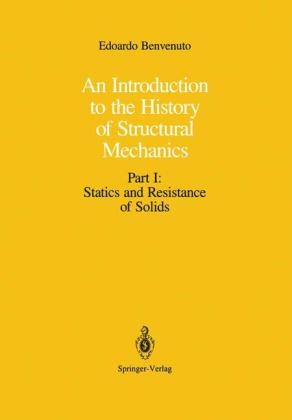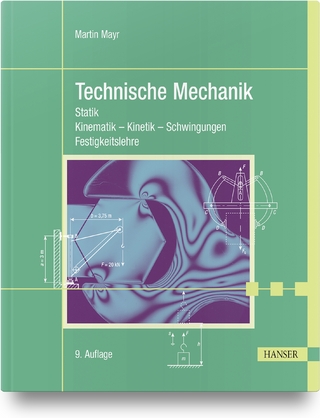
An Introduction to the History of Structural Mechanics
Springer-Verlag New York Inc.
978-0-387-96227-6 (ISBN)
- Titel ist leider vergriffen;
keine Neuauflage - Artikel merken
This book is the first to show how statics, strength of materials, and elasticity grew alongside existing architecture with its millenial traditions, its host of successes, its ever-renewing styles, and its numerous problems of maintenance and repair. In connection with studies toward repair of the dome of St. Peter's by Poleni in 1743, on p.
of Part I.- I The Principles of Statics.- 1 Methodological Preliminaries.- 1.1 The Special Objects That Gave Rise to Mechanics.- 1.2 The Enigma of Force and the Foundations of Mechanics.- 1.3 Statics as "Science Subordinated to Geometry as Well as to Natural Philosophy".- 1.4 Momentum: Fixed Word, Fluid Concept.- 1.5 The Aristotelian Roots of a Vocabulary for Mechanics.- 1.6 A Short Outline of Aristotle's Physical Principles.- 1.7 Modern Metamorphoses of the Immobile Mover: Towards the Principle of Conservation.- 1.8 The "Mechanical Problems": The Peripatetic Explanation of the Law of the Lever and the Parallelogram Rule.- 2 The Law of the Lever.- 2.1 Archimedes' Demonstrations.- 2.2 Interpretations (and Improvements) of Archimedes' Proof.- 2.3 An Alternative Approach: Pseudo-Euclid and Huygens.- 2.4 Marchetti's New Approach and Daviet de Foncenex's Improvements.- 2.5 De la Hire's Proof, Lagrange's Remarks and Fourier's Contribution.- 2.6 Towards the "Dethronement" of the Law of the Lever: Saccheri and de Maupertuis.- 3 The Principle of Virtual Velocities.- 3.1 Medieval Roots.- 3.2 Guidobaldo del Monte, Galileo, and the Principle.- of Virtual Velocities.- 3.3 Descartes: "Explicatio Machinarum Unico Tantum Principio".- 3.4 Bernoulli and Varignon.- 3.5 Riccati's "Universal Principle of Statics".- 3.6 Lagrange's First Demonstration.- 3.7 The Approaches of Fossombroni and Fourier.- 3.8 The Principle of Virtual Velocities and Constraints: Poinsot's and Ampere's Contributions and Lagrange's Second Proof.- 4 The Parallelogram of Forces.- 4.1 Daniel Bernoulli's Claim.- 4.2 Daniel Bernoulli's First Geometrical Demonstration.- 4.3 Bulffinger's Paradox.- 4.4 Riccati's Solution.- 4.5 Foncenex's Memoir and Lagrange's Criticism.- 4.6 Foncenex's Fundamental Lemma.- 4.7 Foncenex's and D'Alembert's Functional Equation.- 4.8 D'Alembert's Memoir of 1769.- 4.9 Further Developments: D'Alembert, Poisson, Cauchy, Dorna and Darboux.- 4.10 Conclusion.- II De Resistentia Solidorum.- 5 Galileo and His "Problem".- 5.1 Introduction.- 5.2 Galileo: A Short Account.- 5.3 The Subtext: Galileo's Atomism.- 5.4 The Primacy of Geometry over Logic in the Discorsi.- 5.5 The First Day of the Discorsi.- 5.6 Attempts to Explain the Cause of Resistance.- 5.7 For and Against the Power of the Vacuum.- 5.8 First Intimations of an Atomistic Theory of Resistance.- 5.9 Democritus or Plato?.- 5.10 The Second Day.- 5.11 Opening Remarks.- 5.12 Corollaries.- 5.13 The Problem of Solids of Ultimate Dimensions.- 5.14 The Problem of Solids of Equal Resistance.- 6 First Studies on the Causes of Resistance.- 6.1 Experimental Confutations: The Horror Vacui.- 6.2 Mersenne and the Problem of Resistance.- 6.3 Descartes' Concept: Stasis as the Best Adhesive.- 6.4 The Atomist Rossetti and His Explanation of Resistance.- 6.5 Atomism and Vacuum: Newton, Leibniz and Clarke.- 6.6 Newton's "vis interna attrahens": Elasticity and Resistance.- 6.7 Boscovich's Reformation of the Old Atomism.- 6.8 Developments of Boscovich's Theory: Early Nineteenth-Century Research on Elasticity.- 7 The Initial Growth of Galileo's Problem.- 7.1 Introduction.- 7.2 First Steps in the Controversy about Solids of Equal Resistance: Blondel's "Evidence".- 7.3 Marchetti's "Evidence" on Solids of Equal Resistance.- 7.4 Marchetti's Axiomatic Approach to the Resistance of Solids.- 7.5 Viviani's "Evidence".- 7.6 Antony Terill and Solids of Ultimate Dimensions.- 7.7 Fabri: Elasticity as an "Intermediate Force".- 7.8 Pardies' Statics.- 8 Early Theories of the Strength of Materials.- 8.1 Elasticity Enters the Theory of Resistance.- 8.2 Mariotte's Contribution.- 8.3 Leibniz's New Demonstrations.- 8.4 New Problems: Catenaries and Elastic Curves.- 8.5 Jakob Bernoulli'of Part I.- I The Principles of Statics.- 1 Methodological Preliminaries.- 1.1 The Special Objects That Gave Rise to Mechanics.- 1.2 The Enigma of Force and the Foundations of Mechanics.- 1.3 Statics as "Science Subordinated to Geometry as Well as to Natural Philosophy".- 1.4 Momentum: Fixed Word, Fluid Concept.- 1.5 The Aristotelian Roots of a Vocabulary for Mechanics.- 1.6 A Short Outline of Aristotle's Physical Principles.- 1.7 Modern Metamorphoses of the Immobile Mover: Towards the Principle of Conservation.- 1.8 The "Mechanical Problems": The Peripatetic Explanation of the Law of the Lever and the Parallelogram Rule.- 2 The Law of the Lever.- 2.1 Archimedes' Demonstrations.- 2.2 Interpretations (and Improvements) of Archimedes' Proof.- 2.3 An Alternative Approach: Pseudo-Euclid and Huygens.- 2.4 Marchetti's New Approach and Daviet de Foncenex's Improvements.- 2.5 De la Hire's Proof, Lagrange's Remarks and Fourier's Contribution.- 2.6 Towards the "Dethronement" of the Law of the Lever: Saccheri and de Maupertuis.- 3 The Principle of Virtual Velocities.- 3.1 Medieval Roots.- 3.2 Guidobaldo del Monte, Galileo, and the Principle.- of Virtual Velocities.- 3.3 Descartes: "Explicatio Machinarum Unico Tantum Principio".- 3.4 Bernoulli and Varignon.- 3.5 Riccati's "Universal Principle of Statics".- 3.6 Lagrange's First Demonstration.- 3.7 The Approaches of Fossombroni and Fourier.- 3.8 The Principle of Virtual Velocities and Constraints: Poinsot's and Ampere's Contributions and Lagrange's Second Proof.- 4 The Parallelogram of Forces.- 4.1 Daniel Bernoulli's Claim.- 4.2 Daniel Bernoulli's First Geometrical Demonstration.- 4.3 Bulffinger's Paradox.- 4.4 Riccati's Solution.- 4.5 Foncenex's Memoir and Lagrange's Criticism.- 4.6 Foncenex's Fundamental Lemma.- 4.7 Foncenex's and D'Alembert's Functional Equation.- 4.8 D'Alembert's Memoir of 1769.- 4.9 Further Developments: D'Alembert, Poisson, Cauchy, Dorna and Darboux.- 4.10 Conclusion.- II De Resistentia Solidorum.- 5 Galileo and His "Problem".- 5.1 Introduction.- 5.2 Galileo: A Short Account.- 5.3 The Subtext: Galileo's Atomism.- 5.4 The Primacy of Geometry over Logic in the Discorsi.- 5.5 The First Day of the Discorsi.- 5.6 Attempts to Explain the Cause of Resistance.- 5.7 For and Against the Power of the Vacuum.- 5.8 First Intimations of an Atomistic Theory of Resistance.- 5.9 Democritus or Plato?.- 5.10 The Second Day.- 5.11 Opening Remarks.- 5.12 Corollaries.- 5.13 The Problem of Solids of Ultimate Dimensions.- 5.14 The Problem of Solids of Equal Resistance.- 6 First Studies on the Causes of Resistance.- 6.1 Experimental Confutations: The Horror Vacui.- 6.2 Mersenne and the Problem of Resistance.- 6.3 Descartes' Concept: Stasis as the Best Adhesive.- 6.4 The Atomist Rossetti and His Explanation of Resistance.- 6.5 Atomism and Vacuum: Newton, Leibniz and Clarke.- 6.6 Newton's "vis interna attrahens": Elasticity and Resistance.- 6.7 Boscovich's Reformation of the Old Atomism.- 6.8 Developments of Boscovich's Theory: Early Nineteenth-Century Research on Elasticity.- 7 The Initial Growth of Galileo's Problem.- 7.1 Introduction.- 7.2 First Steps in the Controversy about Solids of Equal Resistance: Blondel's "Evidence".- 7.3 Marchetti's "Evidence" on Solids of Equal Resistance.- 7.4 Marchetti's Axiomatic Approach to the Resistance of Solids.- 7.5 Viviani's "Evidence".- 7.6 Antony Terill and Solids of Ultimate Dimensions.- 7.7 Fabri: Elasticity as an "Intermediate Force".- 7.8 Pardies' Statics.- 8 Early Theories of the Strength of Materials.- 8.1 Elasticity Enters the Theory of Resistance.- 8.2 Mariotte's Contribution.- 8.3 Leibniz's New Demonstrations.- 8.4 New Problems: Catenaries and Elastic Curves.- 8.5 Jakob Bernoulli's Fundamental Work.- 8.6 Varignon and the Galileo-Mariotte Dichotomy.- 8.7 Musschenbroek and the Imperfections of Matter.- 8.8 The Last of the Eighteenth-Century Treatises on Resistance.- Author Index.
| Zusatzinfo | biography |
|---|---|
| Verlagsort | New York, NY |
| Sprache | englisch |
| Gewicht | 615 g |
| Themenwelt | Mathematik / Informatik ► Mathematik |
| Naturwissenschaften ► Physik / Astronomie ► Mechanik | |
| Technik ► Bauwesen | |
| ISBN-10 | 0-387-96227-1 / 0387962271 |
| ISBN-13 | 978-0-387-96227-6 / 9780387962276 |
| Zustand | Neuware |
| Haben Sie eine Frage zum Produkt? |
aus dem Bereich


